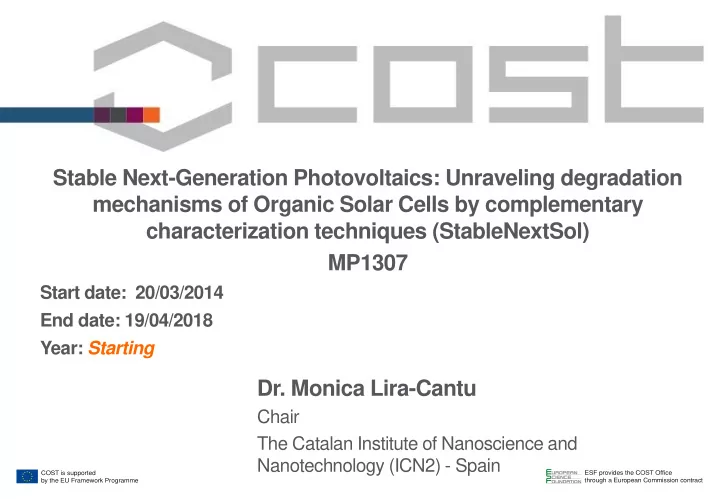

Stable Next-Generation Photovoltaics: Unraveling degradation mechanisms of Organic Solar Cells by complementary characterization techniques (StableNextSol) MP1307 Start date: 20/03/2014 End date: 19/04/2018 Year: Starting Dr. Monica Lira-Cantu Chair The Catalan Institute of Nanoscience and Nanotechnology (ICN2) - Spain COST is supported ESF provides the COST Office by the EU Framework Programme through a European Commission contract
Scientific context and objectives (1/2) Background / Problem statement: To unravel degradation mechanisms of OPVs by complementary characterization techniques in order to develop more stable devices. Brief reminder of MoU objectives: • To take advantage of the different analytical techniques within the consortium to study and understand the degradation of state-of-the-art OPVs. • To create an interdisciplinary network of laboratories, research groups and industry to promote the development of next-generation OPVs with longer lifetimes. • The final desired stability of the OPV devices should be comparable to the current Si-based technology: lifetimes above 20 years. 2 2
Scientific context and objectives (2/2) Research directions: Approach and methodology • All objectives and activities for Y1 are working accordingly to plan. • An on-line survey among partners permitted to distribute members among WGs with well-defined working tasks. • Two MC/WG Meetings for Y1 are underway. A training school is under organization for Y2 in coordination with an ITN Network on OPV stability. Innovative work • We are the first network of the kind to reunite such a large consortium of laboratories working for the same objective. • A new working group has been established to be aware of the state-of-the art in other solar cell technologies. 3
Working Program A. Networking Program • • • • • • B. Science / Technical Program • • • • • • • • 4
Working groups: Networking 1. NG: Networking Group. 2. STG: Science and Technology Group. CHAIR 3. DS: Dissemination Group. VICE-CHAIR 4. IAB: Industry Advisory Board. 5. Ethics Committee. 5
Working groups: Science & Tech. 1. WG 1: Technology Monitoring. 2. WG 2: OPV Fabrication. 3. WG 3: OPV degradation. 4. WG 4: Non-destructive Charact. 5. WG 5: Destructive Characterization. 6. WG 6: New Device Engineering. 6
Future Plans and Challenges Critical Phases/Topics to Address Increase female participation (right now about 40%). Invite partners from NNCs and promote ESRs participation. Participation in H2020 calls. Initiate the scientific program of the Action. Challenges Develop and organize the several degradation mechanisms of OPVs to be employed as reference. Involve Industry in the scientific program. First publications from member should be released by the end of first year. 7
Recommend
More recommend